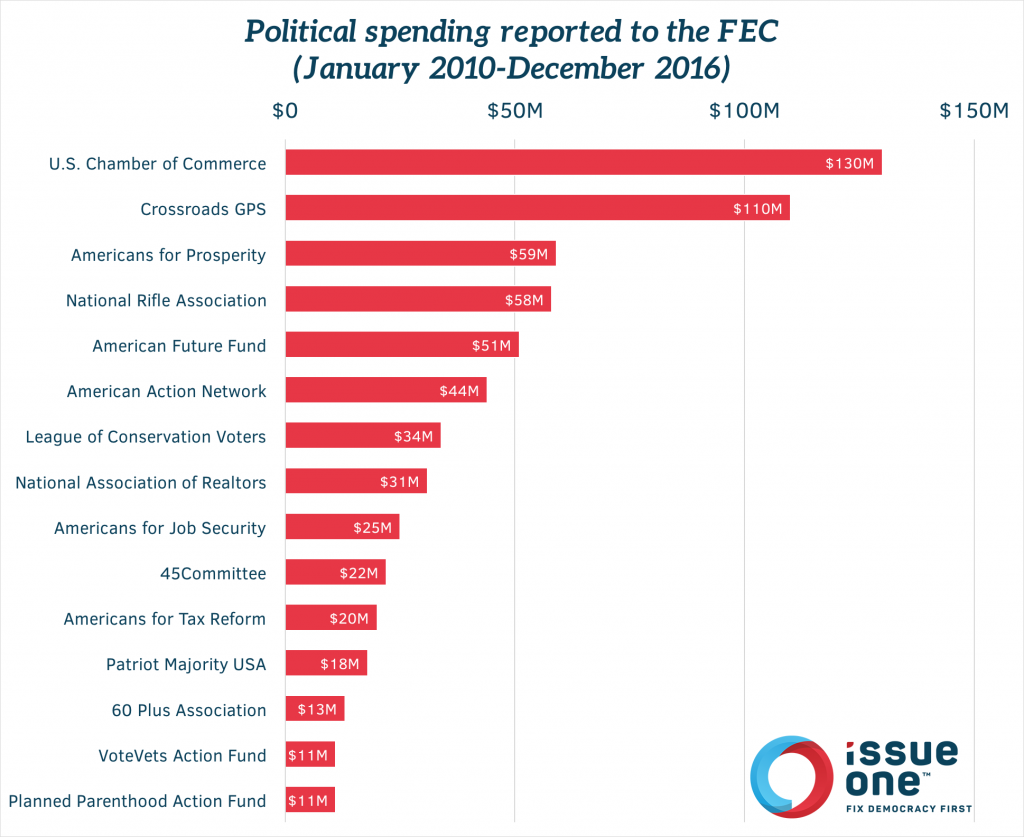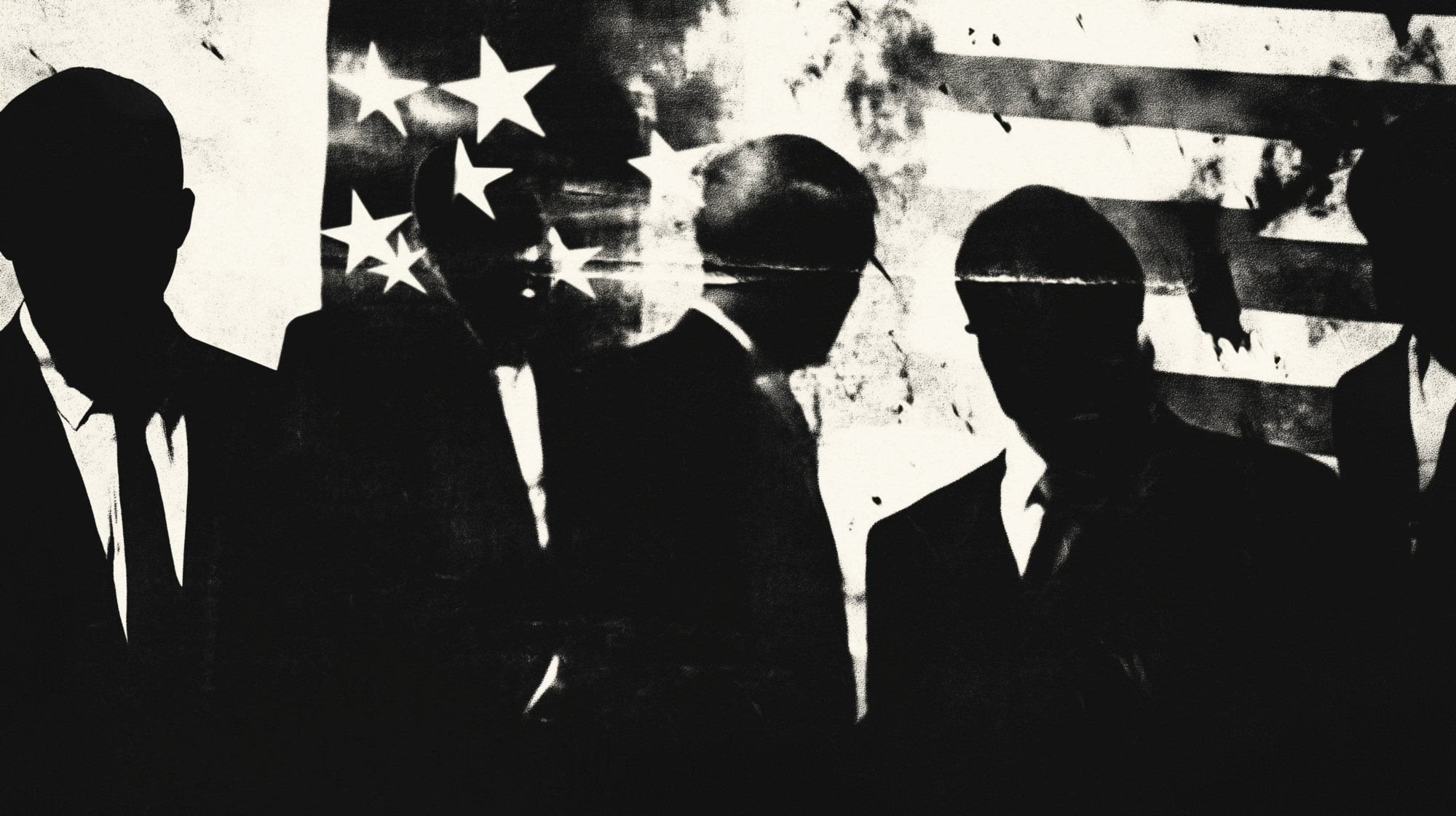Just 15 dark money groups in the post-Citizens United era accounted for over 75 percent of the more than $800 million in political dark money spent between January 2010 and December 2016, according to Issue One’s new year-long investigation, “Dark Money Illuminated.”
During this period, these groups — some of which spent to help Democrats and some of which aided Republicans — reported spending more than $600 million in political dark money to the Federal Election Commission (FEC) and were ranked as the top 15 dark money spenders, according to an Issue One analysis of data from the Center for Responsive Politics and FEC.
“Dark Money Illuminated” shines light on approximately 400 donors and donor organizations who have funded these leading dark money groups that specialize in the attack ads and negative campaigns that are poisoning our elections. These donors are being made searchable in an extensive, first-of-its-kind database containing nearly 1,200 transactions, each supported by primary source documents. You can also see these records in ProPublica’s FEC Itemizer database.
At its core, “Dark Money Illuminated” also highlights how little even the most seasoned experts are able to unearth about the secretive, dark money groups that are coming to define congressional elections.
“If you have the guts to play in politics or attack a candidate running for office, you should have the courage to put your name on it,” said Issue One CEO Nick Penniman. “Right now, the dark money groups and anonymous donors behind them that endlessly bombard Americans with television ads spouting half-truths and outright lies do a disservice to voters. In the internet age, every American should be able to know where the money is being spent and who is giving it in near real-time.”
Nearly every one of these top 15 dark money groups are still active in elections today.

Among them: the U.S. Chamber of Commerce, the nation’s largest lobbying organization for businesses, which ranks as the top-spending dark money group since Citizens United. It spent approximately $130 million on political advertisements to promote and attack candidates between January 2010 and December 2016, in addition to the direct political contributions it made to candidates from its political action committee. That’s about $1 of every $6 spent on political ads by all dark money groups during this time.
Other major dark money players on the top 15 list — all of which are profiled as part of the project and each of which reported spending at least $10 million to the FEC during this period — include: Americans for Prosperity, the flagship politically active nonprofit of the billionaire industrialists Charles and David Koch; Crossroads GPS, a Republican-aligned group associated with former George W. Bush White House advisor Karl Rove; and Patriot Majority USA, an organization led by political operatives with close ties to Democratic Senate leaders Harry Reid and Chuck Schumer.
“Whether you’re a conservative Republican or a progressive Democrat, policy ideas and candidates’ positions should be promoted by organizations who are proud to be engaged in our public arena, not secretive front groups designed to deceive voters, hide donors and deploy deceptive tactics,” said former Ambassador and Rep. Tim Roemer (D-IN), one of the co-chairs of Issue One’s ReFormers Caucus, the 200-member strong coalition of former members of Congress, governors and Cabinet secretaries assembled to advocate to strengthen our democracy.
Added former Rep. Zach Wamp (R-TN), another co-chair of Issue One’s ReFormers Caucus: “Elections shouldn’t be waged in the shadows. Neither Republicans nor Democrats should feel like they need to embrace dark money to win. Voters want to know you are listening to them, not secretive special interest groups.”
Other Issue One key findings from the “Dark Money Illuminated” investigation include:
- Issue One’s research was able to source about $1 of every $9 of the money flowing into these 15 dark money groups since Citizens United — a total of more than $760 million. In a handful of cases, Issue One identified the donors behind more than half of the money the groups had raised; but for some groups, as little as two percent of their funding was able to be linked to donors or donor organizations.
- Trade associations contributed to several of the leading dark money groups in recent years. For example, the American Petroleum Institute (API), the Motion Picture Association of America (MPAA) and Pharmaceutical Research and Manufacturers of America (PhRMA) each contributed to at least five of the top 15 dark money groups. During this time, PhRMA contributed $12 million alone to the American Action Network — making the drug lobby this dark money group’s top known donor.
- For 14 of the 15 dark money groups, more than half of the spending they reported to the FEC on ads overtly calling for the election or defeat of candidates was negative, showcasing the role these organizations have as attack dogs that frequently malign candidates from the shadows. Six dark money groups — the American Action Network, Americans for Job Security, Americans for Prosperity, Americans for Tax Reform, Crossroads GPS and Patriot Majority USA — self-reported to the FEC that more than 90 percent of their spending was negative between January 2010 and December 2016.
- The League of Conservation Voters is the top-spending dark money group that consistently backs Democratic candidates. It told the FEC it spent roughly $34 million between January 2010 and December 2016 on elections.
- Just two donors to the Planned Parenthood Action Fund accounted for nearly one-third of the $179 million it raised between July 2009 and June 2017. One of these is the Susan Thompson Buffett Foundation, which is primarily funded by billionaire investor Warren Buffett and is named for his late wife. The $26 million in grants this foundation gave were earmarked for “the charitable purpose of reproductive health advocacy.”
- Eight of the groups self-reported to the IRS that at least 25 percent of their spending during the past eight years was election-focused in nature. Such spending has exceeded 40 percent — and sometimes even more than 50 percent — for some groups during certain election years.
- For instance, the VoteVets Action Fund self-reported to the IRS spikes in “direct or indirect political activities” during election years — exceeding 48 percent and 52 percent amid the 2010 and 2012 elections, respectively.
- Three of these groups — the 60 Plus Association, Americans for Tax Reform and the National Rifle Association — have major discrepancies between what they reported spending on politics to IRS versus what they told the FEC they spent on ads that expressly advocated for the election or defeat of federal candidates.
- Four of these groups — the American Action Network, the American Future Fund, Americans for Job Security and Crossroads GPS — have seen complaints filed against them with the FEC urging the commission to investigate whether they should have registered as a political committee, which would have required the groups to disclose their donors. In each case, the FEC has deadlocked, failing to earn the four votes necessary for the six-member commission to take action.
To create the exhaustive, first-of-its-kind database and paint as comprehensive a picture as possible from public records about what interests have bankrolled these 15 major dark money groups, researchers at Issue One scoured FEC filings, tax returns, annual reports submitted by labor unions to the Labor Department, documents submitted to Congress by registered lobbyists, corporate filings, news articles, press releases and myriad other sources.
Learn about the donors, key findings, and profiles of the top 15 dark money groups.
Explore the data.







